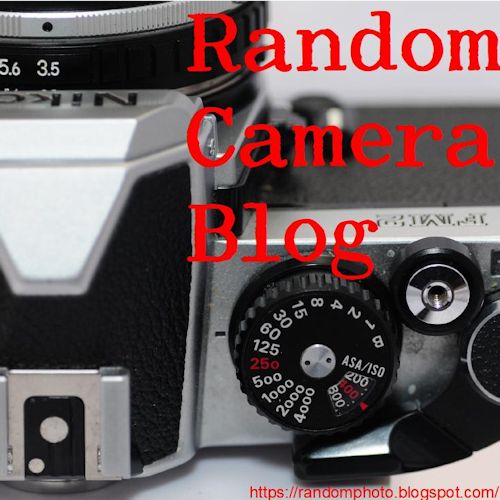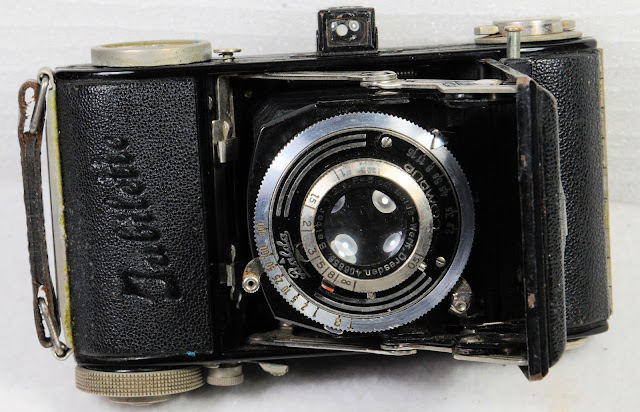
Folding cameras, no matter what format, are an interesting concept. From the early bellows-style cameras that took film plates to the Polaroid Land cameras and the SX-70, the idea of making a camera more compact and easier to carry has a long history. Not only are you unfolding a camera, you are changing its dimensions to accommodate a lens of a particular focal length, hence the bellows. A No. 4 Folding Kodet Kodak camera from 1894 has a bellows that extends from a box-like rear. There is not too much involved in extending the bellows on the camera. Later, the No. 3A Special in 1914 used roll film and the bellows is extended from a compartment to the lens board on the front of the camera, changing its overall shape from a relatively compact flattened item to a body with a bellows at a right angle, extending on a bed. That configuration became popular with roll film cameras into the 1950s. The technology improved with self-erecting fronts (the front standard pops up when the bellows is extended), better shutters, better viewfinders, including rangefinder focus on some models of medium and 35mm format folding cameras. Of course, the smaller the format, the shorter the focal distance for the lens, with 35mm cameras requiring a very short bellows to operate. Thus, 35mm folding cameras, which date from the late 1930s into the late 1950s were an alternative to the solid-bodied 35mm cameras from Argus, Leitz and Zeiss. The folding 35mm cameras were discussed by me in a previous post here on RCB.
 |
Kodak Premoette Jr. No. 1, 1913. All those dangly bits
are protected when it's folded. |
The beauty of a folder is that once the front of the camera has been closed, it’s quite easy to carry in a pocket, and the optics are well-protected inside that closed camera. For 35mm cameras, it really makes them quite compact with no big protrusions to prevent them from being easily retrieved from a pocket. Press a button and they magically unfold, ready to use.
While the Kodak Retina series remain the best-known 35mm folders for good reason, other European companies made them, including Agfa, Balda, Beier, Certo, Voigtlander, Welta, and Zeiss Ikon.
Balda Jubilette
The Jubilette, so-named for Balda-Werke’s 30th anniversary, is a pre-war (WWII) 1938-40 camera that is similar to the 1935 Baldina. The Baldina has many variants with different lens/shutter combinations, and I suppose making the Jubilette was an easy way to honor the company’s 30 years. It’s not a complicated camera, and it’s certainly capable of good results. It’s also not terribly different from a Kodak Retina 1.
Some features of the Jubilette
 |
The Jubilette in closed position. That's the shutter release
on the right of the viewfinder, on the extending bed. |
The Jubilette that I have has a front release button on the top plate of the camera. Push it in, and the front pops open, erecting the front with a nice solid-sounding klunk. The Compur shutter has speeds from T, B, 1-1/300 s, and the lens is a Baltar 5 cm f/2.9 with apertures down to f/16.
The shutter release is on the left of the front standard (as you are holding it), which means your left hand controls the shutter release, and while not typical, it makes sense for this camera. The viewfinder is fairly simple, and does not correct for parallax. The close focus distance of this camera is 50 cm, which is pretty close. As you’ll see in a photo below, parallax correction would be nice.
The back of the camera features a zone focus chart, which is actually quite useful. If you are shooting at f/11, everything is in focus from 2.4m to infinity. Basically, that means you don’t have to refocus at anything from about 8 feet and beyond on a bright sunny day. To focus, simply turn the knurled front edge of the lens mount so that the estimated distance is in line with the red indicator.
 |
| Follow the arrows to open the back |
 |
| Note the unique take-up spool configuration. |
Loading the film requires you to slide the chrome tab on the side upwards and push the back away from the body, which is easiest if you close the front standard. Note that the little handle remains stationary, so don’t pull on the handle to open the back. The first thing that you’ll notice is that the reception for the film leader does not extend to the edge of the spool. Instead there is a centrally place slot, which means that you’ll have to trim the film leader to fit in that slot. To advance the film, you push down on the small knob next to the film advance wheel and let up as soon as you start turning the film advance clockwise. The wheel will stop rotating once it has reached the spot for the next frame.
 |
| Press the smaller button down before winding on to the next frame. |
Once you have advanced the film, cock the shutter by rotating the cocking lever clockwise. A small tab on the bottom of the lens sets the aperture, and the knurled front ring rotates to choose the shutter speed. This is called a rim-set shutter. There is a screw-in hole on the edge of the front standard for a cable release. If you wish to take a double exposure, simply reset the shutter. My standard practice is to always advance the film after each shot, and not worry if I have already exposed a frame the next time I pick up the camera.
 |
| Aperture, shutter speed, and focus are all around the front. |
When you reach the end of the roll, pull up the film advance wheel and rotate the keyed film rewind clockwise. The frame counter on the top deck of the camera is an additive one, meaning that it shows how many exposures you have made. When you insert a new roll of film, set the counter to zero by turning the raised center to get the number in the window to zero.
Overall, it’s a fairly easy camera to operate, and once you get accustomed to its workings, it handles pretty well, especially for an 85 year old camera. Think about it. This particular camera is in pretty good condition and works just as it should. No bellow pinholes, either. I guess some jubilation is in order just for that fact!
Some things to remember
If you hold down the film advance release button too long, you may advance more than one frame before the wind button stops turning. So just do a brief push on that button and release it as soon as you start advancing the film.
Since there is no focus aid, you’ll need to guestimate your focus when you rotate the focus distance on the front of the camera. If you are shooting at f/16, anything past 6 feet will be in focus if set at the 2 m mark.
The viewfinder is approximate — it works to generally frame your subject, but it isn’t anything like a nice Retina IIc.
Some sample images
I shot a roll of Eastman 5231 an ISO 80-100 film. Other than some blank frames where I wound on past the next frame, it had relatively good results. Sometimes the frame spacing was tight, though.
 |
| as you can see, parallax can throw you off. |
Buying a Balda Jubilette
If the camera is in clean, working condition, expect to pay from $75 to $130 for one. While they are not rare, they are uncommon, especially in the United States. If you are looking at one, make sure all the functions work as they should. Balda made hundreds of different cameras, and I suppose building a Balda collection would be quite an undertaking. However, if you just stuck with their 35mm cameras, it would still be a formidable task. Balda-Werke was destroyed in Dresden in 1945, and in 1946 moved to Bünde, West Germany, and the company renamed as Balda-Werke Bünde. They manufactured cameras into the 1970s, often as an OEM for companies like Argus.















































